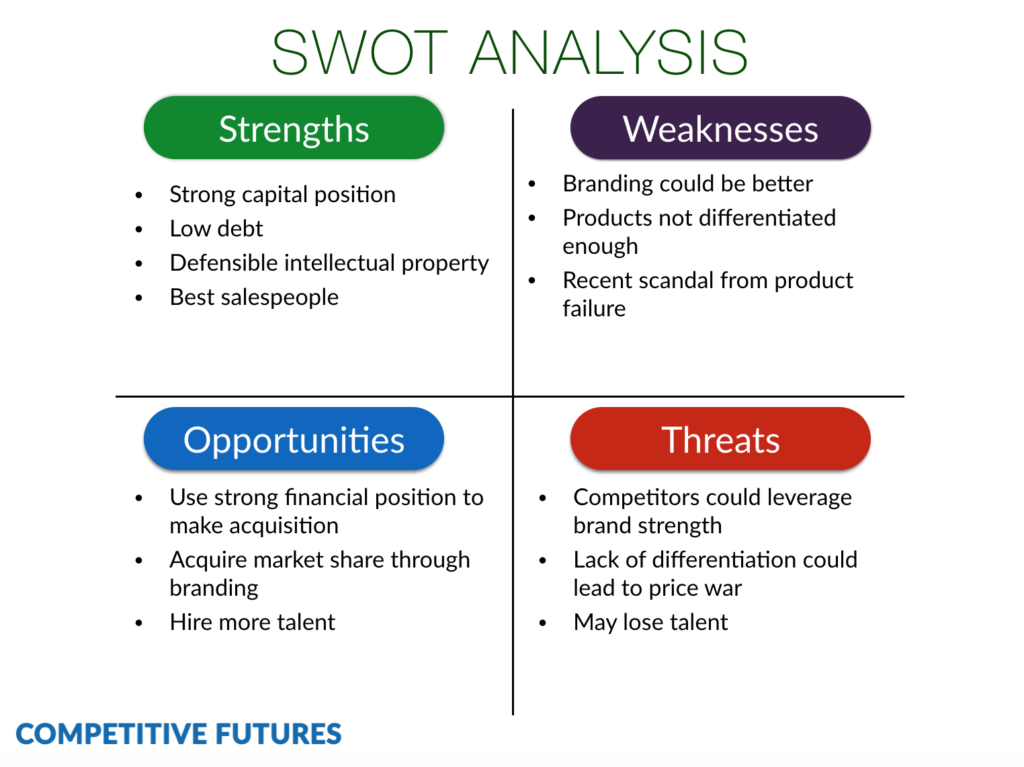Why SWOT analysis sucks – and how to make it better with future trends
The above graphic depicts SWOT Analysis, a business strategy tool that invites executives to ponder their firm’s strategic position by considering their own inherent Strengths and Weaknesses. Then, considering whatever change is happening in the market space, executives look for potential Opportunities and Threats, based on their assessment of their own firm.
When SWOT was unveiled as an analytical tools for business, it allowed for an abstract view of strategic positioning that was innovative for the time, and better than nothing. The proposed value of the tool is that it makes you stop and think about what your firm is doing and how competitors might exploit that.
An example of a SWOT analysis might look like this:
“What’s wrong what that?” you might say. This matrix offers some insight from the executives and some strategic directions the hypothetical firm might take. Ah, but in practice, here’s what fundamental problems are hidden in a SWOT analysis?
Internal politics – SWOT analysis is usually done internally and inherently involves self-criticism. You’re forced – as an individual executive – to point out openly what you like and dislike about the company. That opens you to political infighting, so people are more likely to self-censor and infuse the critical first two categories with inaccurate information.
Cognitive bias – The various forms of cognitive bias on strategic analysis (social bias, memory bias, probability bias, decision bias) wreak havoc with SWOT. The forward-looking parts of the matrix – risks and opportunities – are a fertile field for terrible thinking biased by social hierarchies, rosy visions of the past, Not Invented Here dismissals, and much more.
Navel gazing – Above all, 99.99% of SWOT analyses are conducted without a robust set of data from intelligence gathering about the world on hand. Executives are essentially trying to predict the future (risks and opportunities) based on the competitive landscape (in which they have strengths and weaknesses) with only their vague internal impressions to make the decision. Where are the future trends? Disruptive technologies? Forward-looking competitor intelligence profiles? Nowhere to be found.
So basically, SWOT analysis lacks everything that Competitive Futures stands for and provides as a service, ergo we are not big fans.
HOW FUTURE INTELLIGENCE CAN MAKE SWOT POWERFUL AGAIN
SWOT analysis isn’t, in and of itself, a bad design for a strategy tool. It’s quick and dirty, and should be able to get a group of people thinking about their competitive position in short order. But, as we show above, it has some design flaws that frequently render it not only useless, but harmful.
The good news is that with some simple additions to the information supplied into the SWOT matrix, you can use as a jumping off point for a tool that has real foresight power. Our Future Intelligence model shows executives how to look at their competitive landscape in terms of systems, strategic trends, expert forecasts, implications, and then scenarios. That’s a little unwieldy to put into a SWOT matrix, but the part that can really help would be trends. Doing a little STEEP trend analysis, you could take the initial SWOT matrix, and ask which Social, Technological, Economic, Ecological, and Political trends might impact the short- to mid-term future that the SWOT is trying to address. You would also need updated and accurate competitor intelligence profiles to understand the specifics of your opponents in the market place.
Let’s say you added the following trends:
• Macroeconomics (interest rates, labor participation)
• Tech (patent and trademark registration)
• Market assessment (China, Brazil, etc)
…plus what you know about competitors. You could come up with a much more fine-tuned, specific and actionable set of insights just from humble old SWOT.
Instead of speaking in the general terms of your average SWOT, you can get into specific issues that your colleagues can discuss in some depth. This is the process that takes you closer to actionable intelligence, which is the only kind worth your time and money.
To conclude, Competitive Futures believes that, in general, SWOT sucks – but that with a little elbow grease, it doesn’t have to.
Downloaded from https://www.competitivefutures.com/swot-analysis-sucks-future-trends/ 26 July 2017



